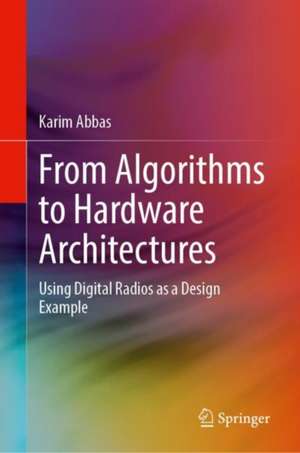From Algorithms to Hardware Architectures: Using Digital Radios as a Design Example
Autor Karim Abbasen Limba Engleză Hardback – 6 aug 2022
- Provides a guide to basebandradio design for Wi-Fi and cellular systems, from an implementation-focused, perspective;
- Explains how arithmetic is moved to hardware and what the cost of each operation is in terms of delay, area and power;
- Enables strategic architectural decisions based on the algorithm, available processing units and design requirements.
| Toate formatele și edițiile | Preț | Express |
|---|---|---|
| Paperback (1) | 535.01 lei 6-8 săpt. | |
| Springer International Publishing – 6 aug 2023 | 535.01 lei 6-8 săpt. | |
| Hardback (1) | 710.88 lei 6-8 săpt. | |
| Springer International Publishing – 6 aug 2022 | 710.88 lei 6-8 săpt. |
Preț: 710.88 lei
Preț vechi: 836.33 lei
-15% Nou
Puncte Express: 1066
Preț estimativ în valută:
136.02€ • 142.42$ • 112.82£
136.02€ • 142.42$ • 112.82£
Carte tipărită la comandă
Livrare economică 09-23 aprilie
Preluare comenzi: 021 569.72.76
Specificații
ISBN-13: 9783031086922
ISBN-10: 3031086929
Pagini: 425
Ilustrații: XXIII, 425 p. 234 illus., 83 illus. in color.
Dimensiuni: 155 x 235 mm
Greutate: 0.81 kg
Ediția:1st ed. 2023
Editura: Springer International Publishing
Colecția Springer
Locul publicării:Cham, Switzerland
ISBN-10: 3031086929
Pagini: 425
Ilustrații: XXIII, 425 p. 234 illus., 83 illus. in color.
Dimensiuni: 155 x 235 mm
Greutate: 0.81 kg
Ediția:1st ed. 2023
Editura: Springer International Publishing
Colecția Springer
Locul publicării:Cham, Switzerland
Cuprins
What is a radio?.- Basics of baseband radios.- Multiplications to multipliers: performing arithmetic in hardware.- The wireless channel.- Baseband modulation.- Forward error correction.- OFDM.- Algorithm to hardware, FFT as a case study.- MIMO.- Advanced issues in migrating to hardware, MIMO decoders as case studies.- Synchronization.- Cellular radios.
Notă biografică
Karim Abbas received his Ph.D. in electrical engineering from UCLA in 2009. Since then he has been an assistant professor at Cairo University in Cairo, Egypt. His main area of interest is the intersection of systems level design and digital circuits design. He has been doing research on and teaching digital circuit design for nineteen years.
·
·
Textul de pe ultima copertă
This book uses digital radios as a challenging design example, generalized to bridge a typical gap between designers who work on algorithms and those who work to implement those algorithms on silicon. The author shows how such a complex system can be moved from high-level characterization to a form that is ready for hardware implementation. Along the way, readers learn a lot about how algorithm designers can benefit from knowing the hardware they target and how hardware designers can benefit from a familiarity with the algorithm. The book shows how a high-level description of an algorithm can be migrated to a fixed-point block diagram with a well-defined cycle accurate architecture and a fully documented controller. This can significantly reduce the length of the hardware design cycle and can improve its outcomes. Ultimately, the book presents an explicit design flow that bridges the gap between algorithm design and hardware design.
- Provides a guide to baseband radiodesign for Wi-Fi and cellular systems, from an implementation-focused, perspective
- Explains how arithmetic is moved to hardware and what the cost of each operation is in terms of delay, area and power
- Enables strategic architectural decisions based on the algorithm, available processing units and design requirements
Caracteristici
Provides a guide to baseband radio design for Wi-Fi and cellular systems, from an implementation-focused, perspective Explains how arithmetic is moved to hardware and what the cost of each operation is in terms of delay, area and power Enables strategic architectural decisions based on the algorithm, available processing units and design requirements
